Description
Kockney Koi Foam Cartridge Replacement Set 10000
These are genuine Kockney koi replacement sets designed for the fibreglass vortex filters. These foam cartridges come as a set of 3.
£54.99 inc. VAT
Kockney Koi Foam Cartridge Replacement Set 10000
These are genuine Kockney koi replacement sets designed for the fibreglass vortex filters. These foam cartridges come as a set of 3.
Kockney Koi Foam Cartridge Replacement Set 10000
These are genuine Kockney koi replacement sets designed for the fibreglass vortex filters. These foam cartridges come as a set of 3.
Only logged in customers who have purchased this product may leave a review.
| Weight | 5 kg |
|---|---|
| Dimensions | 50 × 30 × 20 cm |
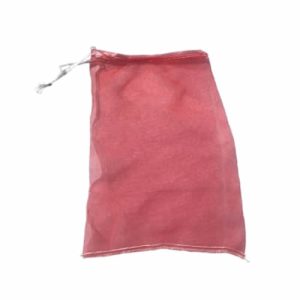
Kusuri Lithaqua Media Sack
Kusuri Lithaqua Media Sack is used with Kusuri Lithaqua Media marine mineral with a high content of minerals, trace elements and carbonates. It brings them into your pond and thereby adjusts the mineral balance and improves the water quality. Use it as pond substrate for bacteria to grow on and for fish to play in, or use it as a filter medium.
Modern multi-chamber filters contain mainly plastic media. Those are excellent supports for bacteria but they do not add anything to water quality. It is important to fill at least one filter chamber (preferably the last chamber) with Kusuri Lithaqua. It provides an enormous surface area for bacteria 10 to 20 times more than most plastic filter media) and provides the bacteria with essential nutrients.
Kusuri Lithaqua neutralises acid pH and helps to restore carbonate alkalinity.
Lithaqua is a marine mineral high in trace elements and carbonates, ideal for raising KH values. A superb filter media of porous construction, allowing a huge surface area for the growth of beneficial bacteria.
Modern filter chambers contain many and varied plastic media, these provide good support – but Lithaqua goes one stage further. Not only do the beneficial bacteria draw on nutrients from the mineral support, the media has a massive surface area up to 20 times greater than most plastic media.
Lithaqua is a biological media not intended for mechanical stages.
Use Lithaqua in a clean water chamber after mechanical removal of waste. Lithaqua is far more efficient than crushed oyster shells, and the high level of carbonates will improve carbonate alkalinity in soft water regions, neutralising low acid pH and buffer swings in pH.
Sack 300mm x 500mm
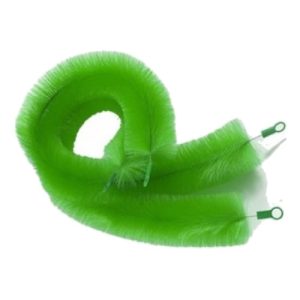
Koi Pro Spawning Brushes
Pack of 2 specially designed soft green spawning brushes each brush measures 1.5m by 140mm diameter.
Spawning is made easy with the help of these specially designed brushes. The breeding season is normally from April to July depending on the weather.
Place the Spawning Brushes just below water level, one above the other, at the edge of the pond, this will
encourages your fish to spawn, usually in the early hours.
Spawning takes several hours with the eggs sticking to the brushes.
After spawning, separate the brushes from the broodfish to avoid the eggs being eaten.
Place the brushes in filtered water of the same temperature and the fry will hatch in 3-6 days.
Small fish should be kept separate until they are large enough to be introduced to the pond.
Please Note: These spawning brushes are made from a soft material that won’t harm your fish. DO NOT USE filter brushes for this purpose
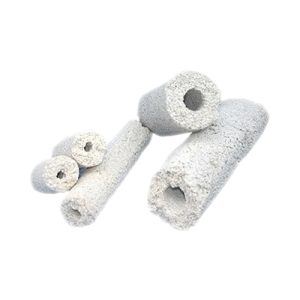
Bacteria Home media
Bacteria home is a high-quality filter medium that is made from mineral rock. This porous rock is baked at a very high temperature. It is ideally suited for a bakki shower, but can also be used in other filters.
The microscopic pores immediately ensure a rapid growth of high concentrations of bacteria, which greatly improves the water quality. The bacteria filter harmful substances such as nitrate, nitrite and ammonia from the water.
The material is very porous and slightly rough on the surface, so that the water that is sprayed over it is, as it were, polished. Because colonies of anaerobic (low-oxygen) bacteria can nest in the pores of this filter media, which take care of the conversion of nitrate to nitrogen gas, you could prefer this type of filter media to non-porous filter media.
Two types of bacteria are involved in the aerobic (oxygen-rich) conversion. The Nitrosomonas bacterium converts ammonia into nitrite and the Nitrobacter bacterium then converts nitrite into nitrate. Although nitrate does not immediately pose a health risk to fish, high doses are not desirable. High nitrate levels promote strong algae growth; this mainly occurs in the spring because the bacteria have not yet multiplied sufficiently.
Anaerobic bacteria are used to convert nitrate into nitrogen gas. This process can only take place in the absence of oxygen, i.e. at places in the filter media where little or no oxygen is present and can reach. The first step in this process is the reversal of the nitrification process. Nitrate is converted back into nitrite. The second step of the denitrification is the conversion of nitrite into nitrogen gas. (N2). This gas can then be released without causing any further damage to the environment.
Bacteria Home also provides an increased mineral and redox value. It also brings considerably more oxygen into the water than, for example, aerated bottom drains. Bacteria Home improves your water quality up to 16 times more effectively than aerated underwater filtration.

NT LABS Zeolite 5kg
Zeolite is commonly used in pond filtration systems to help absorb and remove ammonia and other nitrogenous compounds. Recharging the zeolite helps maintain its effectiveness over time. For best results, use NT Labs Zeolite throughout the year and recharge it regularly. Consider recharging and topping up when water quality begins to decline.
How to use:
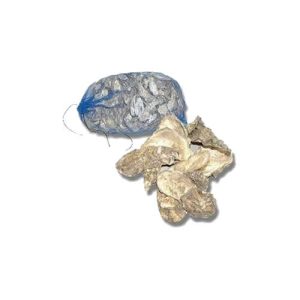
Oyster Shells
Oyster Shells have been used for years by Koi professionals to help with the pH of the water and to maintain optimal water conditions and is extensively used in Japan.
Since the Oyster Shells will generally raise the pH level in your water, these should only be used in cases of low pH.
Oyster Shell generally will raise the level of the pH.
For those that ever ever been to Japan, Oyster shell is used extensively by the breeders in Japan, these soluble (soft) shells are used to stabilise the pH.
Oyster shells stabilise the pH / KH-value which prevents pH crash. If the KH value drops to this starts to dissolve the shells until balance is reached again. Nitrifying bacteria also grows on the oyster shell.

Alfagrog
Alfagrog is a porous foamed ceramic material, which is lightweight, strong and inert.
It’s high surface area makes it the natural choice for colonisation by micro-organisms in biological filtration systems resulting in cleaner water.
The Alfagrog range of porous ceramic filter media is made under controlled conditions UK.
Selected clays and raw materials are rapidly sintered at high temperature to produce a foamed ceramic porous mass, which is crushed and sieved to a convenient particle size.
Alfagrog is available in a wide range of sizes giving the end user optimum media surface area in varying water flow rates.
The manufacturing process ensures that no substances are present to adversely affect the health of fish or plants. The material is pH neutral and can be used in both freshwater and marine applications.
Why is it so effective:
The key to effective biological filtration is choosing media with the highest surface area possible to allow beneficial bacteria to colonise and remove waste from the water. Alfagrog has an extremely high surface area by volume compared with other types of filter media on the market.
Alfagrog is very inert and soon colonises with beneficial bacteria. Alfagrog is made of a highly porous material that contains many thousands of tiny pockets in which bacteria can thrive making in an ideal material for biological filters
Its only draw back is its sharp on the hands when cleaning so please wear gloves..
Benefits over other filter media:
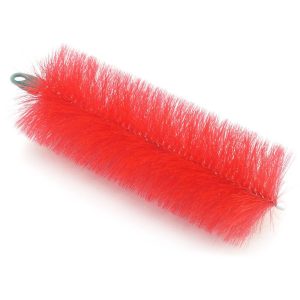
Kockney Koi Filter Brushes (Red)
Kockney Koi Filter Brushes are designed as a pre-filter for removing coarse waste and/or as a biological filter medium. Any design of filtration chamber will suit these brushes and they are easily removed for cleaning. These brushes are 10″ by 4″.
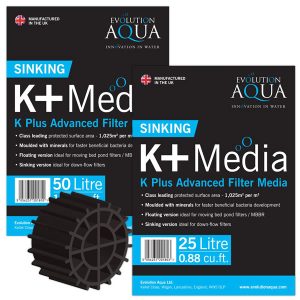
K+ Sinking Filter Media
New advanced filtration media
Plastic media, for use in biological pond filters – specifically in moving bed bio reactors, was pioneered by Evolution Aqua, some 20 years ago. In recent years, other plastic media have come onto the market, usually with the aim of trying to get more and more surface area. However, one drawback to using plastic media has always been the time it takes to establish a stable biofilm – essential for good filtration.
After many years of research, Evolution Aqua have now developed a new media that not only gives class leading surface area, but also overcomes the problem of long maturation times.
Class leading surface area
K+ Sinking Filter Media is designed and manufactured in the UK by Evolution Aqua. This advanced media, with its innovative design, and class leading surface area provides enhanced biological and mechanical filtration.
As Evolution Aqua extrude K+ Media, Minerals and Enzymes are added to the raw material. The result of this process, unique to Evolution Aqua, is a filtration media that not only out performs most of it’s competitors due to its large protected surface area, but also answers the problem of how to speed up the time taken to mature your filter.
Minerals added for faster filter maturation
During the extrusion process, Evolution Aqua add a range of minerals, along with magnesium, calcium, enzymes and salt to the raw material that is used to manufacture K+Media. The result means that K+Media will mature much faster than many other types of media.
Increased surface area
With a new shape and profile, K+ Sinking Filter Media has also been designed to have an increased and class leading surface area, meaning an overall surface area of 1,350m2 per m3. More importantly for biological filtration, the protected surface area of K+ Media is 1,025m2 per m3. This allows a stable bio-film to form and remain intact when used in moving bed biological filtration, as in the new Nexus+.
Stable bio-film development
The shape of K+ Sinking Filter Media optimises the amount of “quiet zones” within the media where a stable bio-film can develop. Whilst K+Media keeps the integral profile of K1 Media at its core, there is an extra layer of cells and fins around the outside of each piece that enable microscopic organisms such as Rotifers and Vorticella to thrive. This is an additional benefit as competitor media do not have such “quiet zones” that would allow these higher lifeforms of filter feeders to develop. The bacteria and organisms that form within the bio-film ensure the media delivers optimum levels of biological filtration in the moving bed, which has been proven filtration technology for many years in the fishkeeping hobby.
Evolution Aqua also recommend using K+ Media in combination with the PURE Pond and PURE+ Filter Start Gel to boost bacteria levels which in turn will stick to the media and speed up the maturation process even more.

Kusuri Lithaqua Media Sack
Kusuri Lithaqua Media Sack is used with Kusuri Lithaqua Media marine mineral with a high content of minerals, trace elements and carbonates. It brings them into your pond and thereby adjusts the mineral balance and improves the water quality. Use it as pond substrate for bacteria to grow on and for fish to play in, or use it as a filter medium.
Modern multi-chamber filters contain mainly plastic media. Those are excellent supports for bacteria but they do not add anything to water quality. It is important to fill at least one filter chamber (preferably the last chamber) with Kusuri Lithaqua. It provides an enormous surface area for bacteria 10 to 20 times more than most plastic filter media) and provides the bacteria with essential nutrients.
Kusuri Lithaqua neutralises acid pH and helps to restore carbonate alkalinity.
Lithaqua is a marine mineral high in trace elements and carbonates, ideal for raising KH values. A superb filter media of porous construction, allowing a huge surface area for the growth of beneficial bacteria.
Modern filter chambers contain many and varied plastic media, these provide good support – but Lithaqua goes one stage further. Not only do the beneficial bacteria draw on nutrients from the mineral support, the media has a massive surface area up to 20 times greater than most plastic media.
Lithaqua is a biological media not intended for mechanical stages.
Use Lithaqua in a clean water chamber after mechanical removal of waste. Lithaqua is far more efficient than crushed oyster shells, and the high level of carbonates will improve carbonate alkalinity in soft water regions, neutralising low acid pH and buffer swings in pH.
Sack 300mm x 500mm

Koi Pro Spawning Brushes
Pack of 2 specially designed soft green spawning brushes each brush measures 1.5m by 140mm diameter.
Spawning is made easy with the help of these specially designed brushes. The breeding season is normally from April to July depending on the weather.
Place the Spawning Brushes just below water level, one above the other, at the edge of the pond, this will
encourages your fish to spawn, usually in the early hours.
Spawning takes several hours with the eggs sticking to the brushes.
After spawning, separate the brushes from the broodfish to avoid the eggs being eaten.
Place the brushes in filtered water of the same temperature and the fry will hatch in 3-6 days.
Small fish should be kept separate until they are large enough to be introduced to the pond.
Please Note: These spawning brushes are made from a soft material that won’t harm your fish. DO NOT USE filter brushes for this purpose

Bacteria Home media
Bacteria home is a high-quality filter medium that is made from mineral rock. This porous rock is baked at a very high temperature. It is ideally suited for a bakki shower, but can also be used in other filters.
The microscopic pores immediately ensure a rapid growth of high concentrations of bacteria, which greatly improves the water quality. The bacteria filter harmful substances such as nitrate, nitrite and ammonia from the water.
The material is very porous and slightly rough on the surface, so that the water that is sprayed over it is, as it were, polished. Because colonies of anaerobic (low-oxygen) bacteria can nest in the pores of this filter media, which take care of the conversion of nitrate to nitrogen gas, you could prefer this type of filter media to non-porous filter media.
Two types of bacteria are involved in the aerobic (oxygen-rich) conversion. The Nitrosomonas bacterium converts ammonia into nitrite and the Nitrobacter bacterium then converts nitrite into nitrate. Although nitrate does not immediately pose a health risk to fish, high doses are not desirable. High nitrate levels promote strong algae growth; this mainly occurs in the spring because the bacteria have not yet multiplied sufficiently.
Anaerobic bacteria are used to convert nitrate into nitrogen gas. This process can only take place in the absence of oxygen, i.e. at places in the filter media where little or no oxygen is present and can reach. The first step in this process is the reversal of the nitrification process. Nitrate is converted back into nitrite. The second step of the denitrification is the conversion of nitrite into nitrogen gas. (N2). This gas can then be released without causing any further damage to the environment.
Bacteria Home also provides an increased mineral and redox value. It also brings considerably more oxygen into the water than, for example, aerated bottom drains. Bacteria Home improves your water quality up to 16 times more effectively than aerated underwater filtration.

NT LABS Zeolite 5kg
Zeolite is commonly used in pond filtration systems to help absorb and remove ammonia and other nitrogenous compounds. Recharging the zeolite helps maintain its effectiveness over time. For best results, use NT Labs Zeolite throughout the year and recharge it regularly. Consider recharging and topping up when water quality begins to decline.
How to use:

Oyster Shells
Oyster Shells have been used for years by Koi professionals to help with the pH of the water and to maintain optimal water conditions and is extensively used in Japan.
Since the Oyster Shells will generally raise the pH level in your water, these should only be used in cases of low pH.
Oyster Shell generally will raise the level of the pH.
For those that ever ever been to Japan, Oyster shell is used extensively by the breeders in Japan, these soluble (soft) shells are used to stabilise the pH.
Oyster shells stabilise the pH / KH-value which prevents pH crash. If the KH value drops to this starts to dissolve the shells until balance is reached again. Nitrifying bacteria also grows on the oyster shell.

Alfagrog
Alfagrog is a porous foamed ceramic material, which is lightweight, strong and inert.
It’s high surface area makes it the natural choice for colonisation by micro-organisms in biological filtration systems resulting in cleaner water.
The Alfagrog range of porous ceramic filter media is made under controlled conditions UK.
Selected clays and raw materials are rapidly sintered at high temperature to produce a foamed ceramic porous mass, which is crushed and sieved to a convenient particle size.
Alfagrog is available in a wide range of sizes giving the end user optimum media surface area in varying water flow rates.
The manufacturing process ensures that no substances are present to adversely affect the health of fish or plants. The material is pH neutral and can be used in both freshwater and marine applications.
Why is it so effective:
The key to effective biological filtration is choosing media with the highest surface area possible to allow beneficial bacteria to colonise and remove waste from the water. Alfagrog has an extremely high surface area by volume compared with other types of filter media on the market.
Alfagrog is very inert and soon colonises with beneficial bacteria. Alfagrog is made of a highly porous material that contains many thousands of tiny pockets in which bacteria can thrive making in an ideal material for biological filters
Its only draw back is its sharp on the hands when cleaning so please wear gloves..
Benefits over other filter media:

Kockney Koi Filter Brushes (Red)
Kockney Koi Filter Brushes are designed as a pre-filter for removing coarse waste and/or as a biological filter medium. Any design of filtration chamber will suit these brushes and they are easily removed for cleaning. These brushes are 10″ by 4″.

K+ Sinking Filter Media
New advanced filtration media
Plastic media, for use in biological pond filters – specifically in moving bed bio reactors, was pioneered by Evolution Aqua, some 20 years ago. In recent years, other plastic media have come onto the market, usually with the aim of trying to get more and more surface area. However, one drawback to using plastic media has always been the time it takes to establish a stable biofilm – essential for good filtration.
After many years of research, Evolution Aqua have now developed a new media that not only gives class leading surface area, but also overcomes the problem of long maturation times.
Class leading surface area
K+ Sinking Filter Media is designed and manufactured in the UK by Evolution Aqua. This advanced media, with its innovative design, and class leading surface area provides enhanced biological and mechanical filtration.
As Evolution Aqua extrude K+ Media, Minerals and Enzymes are added to the raw material. The result of this process, unique to Evolution Aqua, is a filtration media that not only out performs most of it’s competitors due to its large protected surface area, but also answers the problem of how to speed up the time taken to mature your filter.
Minerals added for faster filter maturation
During the extrusion process, Evolution Aqua add a range of minerals, along with magnesium, calcium, enzymes and salt to the raw material that is used to manufacture K+Media. The result means that K+Media will mature much faster than many other types of media.
Increased surface area
With a new shape and profile, K+ Sinking Filter Media has also been designed to have an increased and class leading surface area, meaning an overall surface area of 1,350m2 per m3. More importantly for biological filtration, the protected surface area of K+ Media is 1,025m2 per m3. This allows a stable bio-film to form and remain intact when used in moving bed biological filtration, as in the new Nexus+.
Stable bio-film development
The shape of K+ Sinking Filter Media optimises the amount of “quiet zones” within the media where a stable bio-film can develop. Whilst K+Media keeps the integral profile of K1 Media at its core, there is an extra layer of cells and fins around the outside of each piece that enable microscopic organisms such as Rotifers and Vorticella to thrive. This is an additional benefit as competitor media do not have such “quiet zones” that would allow these higher lifeforms of filter feeders to develop. The bacteria and organisms that form within the bio-film ensure the media delivers optimum levels of biological filtration in the moving bed, which has been proven filtration technology for many years in the fishkeeping hobby.
Evolution Aqua also recommend using K+ Media in combination with the PURE Pond and PURE+ Filter Start Gel to boost bacteria levels which in turn will stick to the media and speed up the maturation process even more.

Kusuri Lithaqua Media Sack
Kusuri Lithaqua Media Sack is used with Kusuri Lithaqua Media marine mineral with a high content of minerals, trace elements and carbonates. It brings them into your pond and thereby adjusts the mineral balance and improves the water quality. Use it as pond substrate for bacteria to grow on and for fish to play in, or use it as a filter medium.
Modern multi-chamber filters contain mainly plastic media. Those are excellent supports for bacteria but they do not add anything to water quality. It is important to fill at least one filter chamber (preferably the last chamber) with Kusuri Lithaqua. It provides an enormous surface area for bacteria 10 to 20 times more than most plastic filter media) and provides the bacteria with essential nutrients.
Kusuri Lithaqua neutralises acid pH and helps to restore carbonate alkalinity.
Lithaqua is a marine mineral high in trace elements and carbonates, ideal for raising KH values. A superb filter media of porous construction, allowing a huge surface area for the growth of beneficial bacteria.
Modern filter chambers contain many and varied plastic media, these provide good support – but Lithaqua goes one stage further. Not only do the beneficial bacteria draw on nutrients from the mineral support, the media has a massive surface area up to 20 times greater than most plastic media.
Lithaqua is a biological media not intended for mechanical stages.
Use Lithaqua in a clean water chamber after mechanical removal of waste. Lithaqua is far more efficient than crushed oyster shells, and the high level of carbonates will improve carbonate alkalinity in soft water regions, neutralising low acid pH and buffer swings in pH.
Sack 300mm x 500mm

Koi Pro Spawning Brushes
Pack of 2 specially designed soft green spawning brushes each brush measures 1.5m by 140mm diameter.
Spawning is made easy with the help of these specially designed brushes. The breeding season is normally from April to July depending on the weather.
Place the Spawning Brushes just below water level, one above the other, at the edge of the pond, this will
encourages your fish to spawn, usually in the early hours.
Spawning takes several hours with the eggs sticking to the brushes.
After spawning, separate the brushes from the broodfish to avoid the eggs being eaten.
Place the brushes in filtered water of the same temperature and the fry will hatch in 3-6 days.
Small fish should be kept separate until they are large enough to be introduced to the pond.
Please Note: These spawning brushes are made from a soft material that won’t harm your fish. DO NOT USE filter brushes for this purpose

Bacteria Home media
Bacteria home is a high-quality filter medium that is made from mineral rock. This porous rock is baked at a very high temperature. It is ideally suited for a bakki shower, but can also be used in other filters.
The microscopic pores immediately ensure a rapid growth of high concentrations of bacteria, which greatly improves the water quality. The bacteria filter harmful substances such as nitrate, nitrite and ammonia from the water.
The material is very porous and slightly rough on the surface, so that the water that is sprayed over it is, as it were, polished. Because colonies of anaerobic (low-oxygen) bacteria can nest in the pores of this filter media, which take care of the conversion of nitrate to nitrogen gas, you could prefer this type of filter media to non-porous filter media.
Two types of bacteria are involved in the aerobic (oxygen-rich) conversion. The Nitrosomonas bacterium converts ammonia into nitrite and the Nitrobacter bacterium then converts nitrite into nitrate. Although nitrate does not immediately pose a health risk to fish, high doses are not desirable. High nitrate levels promote strong algae growth; this mainly occurs in the spring because the bacteria have not yet multiplied sufficiently.
Anaerobic bacteria are used to convert nitrate into nitrogen gas. This process can only take place in the absence of oxygen, i.e. at places in the filter media where little or no oxygen is present and can reach. The first step in this process is the reversal of the nitrification process. Nitrate is converted back into nitrite. The second step of the denitrification is the conversion of nitrite into nitrogen gas. (N2). This gas can then be released without causing any further damage to the environment.
Bacteria Home also provides an increased mineral and redox value. It also brings considerably more oxygen into the water than, for example, aerated bottom drains. Bacteria Home improves your water quality up to 16 times more effectively than aerated underwater filtration.

NT LABS Zeolite 5kg
Zeolite is commonly used in pond filtration systems to help absorb and remove ammonia and other nitrogenous compounds. Recharging the zeolite helps maintain its effectiveness over time. For best results, use NT Labs Zeolite throughout the year and recharge it regularly. Consider recharging and topping up when water quality begins to decline.
How to use:
How can we help you? :)
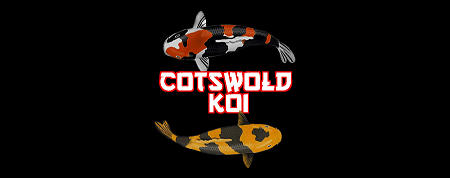

Reviews
There are no reviews yet